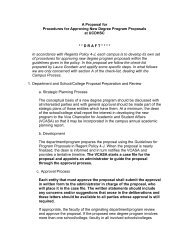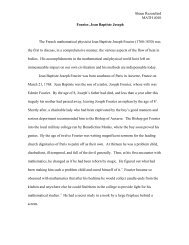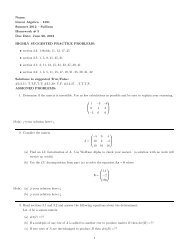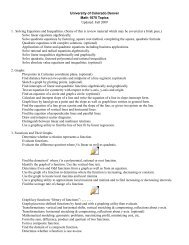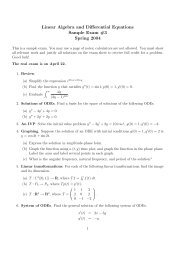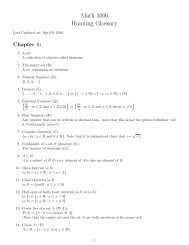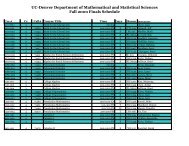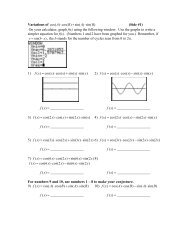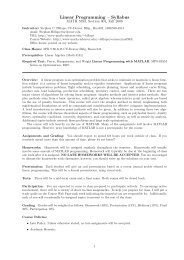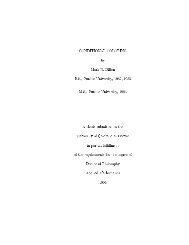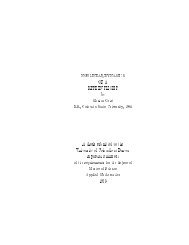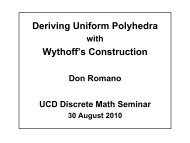A Game-Theoretic Approach to Personnel Decisions in American ...
A Game-Theoretic Approach to Personnel Decisions in American ...
A Game-Theoretic Approach to Personnel Decisions in American ...
You also want an ePaper? Increase the reach of your titles
YUMPU automatically turns print PDFs into web optimized ePapers that Google loves.
Therefore, if we assume that Jay Cutler has a similar <strong>in</strong>fluence <strong>in</strong><br />
Chicago <strong>to</strong> the one he had <strong>in</strong> Denver, then substitut<strong>in</strong>g x ≈ 0.279 <strong>in</strong><strong>to</strong> Table<br />
4, the Chicago Bears improvement <strong>in</strong> pass<strong>in</strong>g model, and perform<strong>in</strong>g the necessary<br />
calculations, gives that the Bears should expect an overall <strong>in</strong>crease of<br />
about 0.799 yards per play.<br />
Also, quite <strong>in</strong>terest<strong>in</strong>gly, because of this anticipated improvement <strong>in</strong><br />
pass<strong>in</strong>g, our model <strong>in</strong>dicates that the Bears should call about 3% more runn<strong>in</strong>g<br />
plays this season and implement a 47 : 53 run/pass ratio. While these<br />
results are not overwhelm<strong>in</strong>gly significant, from a coach<strong>in</strong>g standpo<strong>in</strong>t they are<br />
valuable. They suggest that a strong emphasis should be placed on develop<strong>in</strong>g<br />
the runn<strong>in</strong>g game <strong>in</strong> tra<strong>in</strong><strong>in</strong>g camp and dur<strong>in</strong>g the pre-season, s<strong>in</strong>ce it should<br />
be a central focus on Sunday afternoons.<br />
2009 was a season <strong>to</strong> forget for the Chicago Bears. After beg<strong>in</strong>n<strong>in</strong>g the<br />
season 3-1, the Bears f<strong>in</strong>ished the season an abysmal 7-9. The Bears struggled<br />
all season runn<strong>in</strong>g the football and were held <strong>to</strong> an NFC worst 93.2 yards per<br />
game. Meanwhile, some would argue, they rema<strong>in</strong>ed overly committed <strong>to</strong> the<br />
pass<strong>in</strong>g game, call<strong>in</strong>g a pass play 62% of the time. This idea was echoed by<br />
Bears six-time Pro Bowl l<strong>in</strong>ebacker Brian Urlacher who said,“Look, I love Jay,<br />
and I understand he’s a great player who can take us a long way, and I still<br />
have faith <strong>in</strong> him. But I hate the way our identity has changed. We used <strong>to</strong><br />
establish the run and wear teams down and try not <strong>to</strong> make mistakes, and<br />
we’d rely on our defense <strong>to</strong> keep us <strong>in</strong> the game and make big plays <strong>to</strong> put us<br />
<strong>in</strong> position <strong>to</strong> w<strong>in</strong>. Kyle Or<strong>to</strong>n might not be the flashiest quarterback, but the<br />
guy is a w<strong>in</strong>ner, and that formula worked for us. I hate <strong>to</strong> say it, but that’s<br />
the truth (Urlacher (2010)).” In 2008, the Bears’ run/pass ratio was 44 : 56,<br />
ga<strong>in</strong><strong>in</strong>g approximately 3.74 yards per play. In 2009, with the acquisition of<br />
Jay Cutler, the Bears’ run/pass ratio was 38 : 62, ga<strong>in</strong><strong>in</strong>g approximately 3.68<br />
yards per play. Our model suggests that the Bears should have called a run<br />
play about 47% of the time. For our model, their allocation of run and pass<br />
deviates 9% from our result, imply<strong>in</strong>g that the Bears were play<strong>in</strong>g far from<br />
optimally. Although these results do not validate our prediction, they do give<br />
some explanation as <strong>to</strong> why the Bears underachieved <strong>in</strong> 2009.<br />
6 Summary and Extensions<br />
This paper discusses how player personnel changes alter the run/pass balance<br />
of an offense. Our conclusions have far-reach<strong>in</strong>g implications. Quite unexpectedly,<br />
our results suggest that if a team acquires new personnel that will



